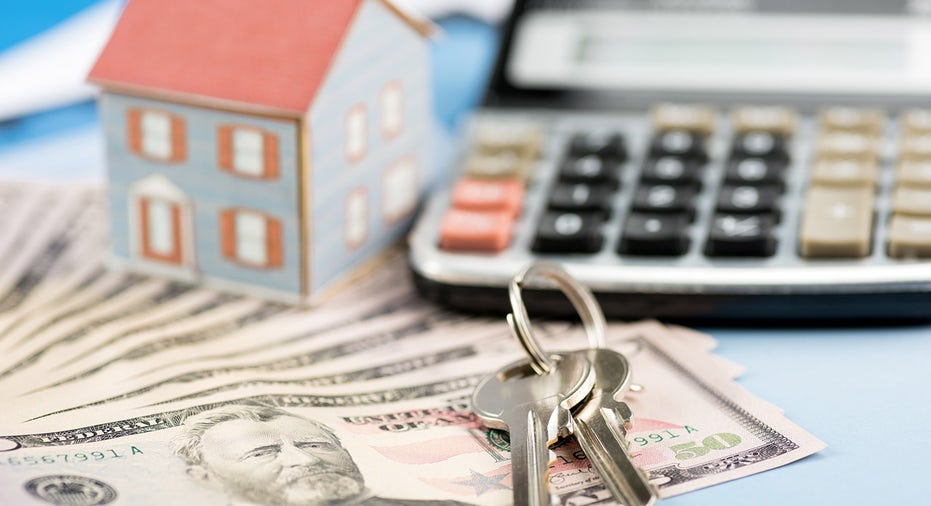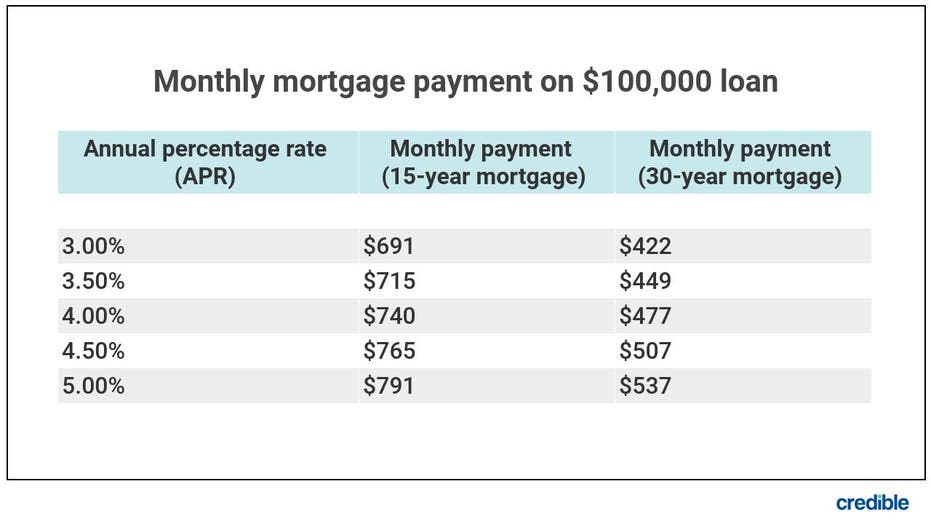Here’s how much a $100,000 mortgage will cost you
A $100,000 mortgage comes with upfront and long-term expenses, but the total cost will depend on your APR and loan term.

If you’re wondering how much a $100,000 mortgage payment will be, check out this primer for answers to your questions. (iStock)
A home payment is often the biggest expense in your monthly budget. And the amount you pay for your mortgage can vary widely depending on several factors, including short-term and long-term expenses.
First, there are upfront costs, like your down payment and closing costs, including title insurance, attorney fees, appraisals and taxes. You’ll also have expenses that span the entire term of the loan, such as your monthly payments, interest and escrow fees.
Before you sign on the dotted line, it’s essential to understand the costs associated with your mortgage.
Credible can help you see how much home you can afford, and help you compare rates from multiple lenders.
- Monthly payments on a $100,000 mortgage
- Will I need a down payment?
- Where to get a $100,000 mortgage
- How to get a $100,000 mortgage
- What to consider before applying for a $100,000 mortgage
Monthly payments on a $100,000 mortgage
Many factors affect your monthly mortgage payment, including the interest rate, repayment term, property taxes and whether you carry private mortgage insurance (PMI).
Your monthly mortgage payment typically consists of the following:
- Principal — The principal is the amount of money you borrow when you take out your home loan. At the beginning of your loan term, only a small portion of your payment goes toward the principal. As time passes, the principal portion of your payment will gradually increase while the interest portion decreases.
- Interest — Interest is what the lender charges you to borrow money, and it represents the biggest chunk of your mortgage payment at the start of the loan. The more you pay on the principal over time, the less interest you’ll owe on the loan.
- Escrow — Your lender may deposit a portion of your mortgage payment into an escrow account to pay for your estimated property taxes and homeowners and mortgage insurance premiums.
The following chart is an example of what the monthly mortgage payment on a $100,000 loan could look like but doesn’t take into account PMI, taxes or other escrow costs.

Will I need a down payment?
A down payment directly affects your monthly mortgage payment. Simply put, a larger down payment amount usually results in lower monthly payments. Since your down payment reduces the balance of your loan, your monthly mortgage payments should be less.
Unless you get a government-backed loan, your lender will likely require a down payment for a mortgage loan. Many lenders require a down payment equal to 20% of the cost of the home you wish to purchase, but not always. Ultimately, the amount you’ll need for a down payment will depend on the type of mortgage you’re applying for.
Here’s a breakdown of the down payment requirements for different types of mortgage loans:
USDA loans
USDA loans are one of two loans (the other being VA loans) that don't require any down payment. If your assets exceed the USDA limits, you may have to use some of your assets toward the loan. While you don’t need a down payment, you will need to come up with the funds to pay for the closing costs.
To qualify for a USDA loan, you’ll need to find a home in an eligible area, usually rural areas with populations below 35,000.
FHA loans
Federal Housing Administration (FHA) loans require down payments as low as 3.5%, although you’ll have to pay a mortgage insurance premium. FHA loans also allow for lower credit scores, making them a helpful option for borrowers with limited savings and lower credit scores.
The FHA doesn’t offer these loans directly. Rather, the agency insures the loans, which are issued by FHA-approved lenders.
Conventional loan
The minimum down payment on a conventional loan is 3%, though most lenders offer conventional loans with down payments ranging from 5% to 15%. But if your down payment is less than 20%, your lender could require you to pay private mortgage insurance as part of your monthly payment. On a conventional loan, the PMI can be eliminated once you have 20% equity in your home.
VA loan
A VA loan is a type of mortgage backed by the U.S. Department of Veterans Affairs. Current service members, eligible veterans and surviving spouses can apply for a mortgage without a down payment or PMI fees, so long as the price of the home isn’t higher than its appraised value. With a VA loan, you may be required to pay a one-time funding fee.
With Credible, you can generate a pre-approval letter and see rates from multiple lenders.
Where to get a $100,000 mortgage
A local bank or credit union may provide a personal experience, especially if you have an existing account there. But online lenders can offer a convenient process you can complete online without ever leaving your home.
It’s always good practice to shop around with various lenders and request quotes to get the lowest available rates. You can prequalify for loan offers by giving some basic information to multiple lenders so they can perform a soft pull of your credit and review your credit score. Once you receive offers, you can compare the loan amount, interest rates, loan terms, fees and other variables from several lenders to find the lowest rate and most affordable option for you.
Credible simplifies this process by allowing you to compare all its partner lenders side-by-side and get prequalified rates within minutes.
How to get a $100,000 mortgage
Getting a $100,000 mortgage may seem like a daunting task, but it’s actually quite simple. By taking the following steps, you may be able to qualify for a mortgage that helps you purchase your dream home:
- Determine how much house you can afford. Review your monthly budget, including your income and expenses. You’ll want to include your down payment in your calculations, and don’t forget the costs of regular home maintenance and repairs, which can range between 1% and 4% of your home’s value per year. A mortgage calculator can be a helpful tool to determine what your monthly payments might be.
- Review your credit report. Your credit report has a big impact on your eligibility for a mortgage and the interest rate you’re offered. That’s why it’s so important to identify any negative marks on your report and address them ahead of time. Look for any mistakes or errors and dispute them with the credit-reporting agencies to get them removed before you apply for a loan.
- Get a pre-approval letter. Pre-approval letters let home sellers know you’re a serious buyer and instill confidence in your purchase offer for a home. The letter also lets you know the loan amount you could qualify for.
- Shop around and compare APRs. When you apply for a pre-approval, lenders will typically send you a loan estimate that discloses the costs and fees included in the loan. With several loan estimates in hand, you can compare offers to identify which one provides the best option for you. Note that the annual percentage rate (APR) is different from the interest rate because it includes other expenses, such as the origination fee, appraisal fee and mortgage insurance.
- Submit a full mortgage application. Once a seller accepts your purchase offer, the next step is to choose a mortgage lender and complete a formal mortgage application. Be prepared to submit supporting financial documents like pay stubs, W-2s and bank and investment account records. When you submit your application, the lender will verify your financial information to determine if you’re financially able to repay the loan you’re seeking.
- Get ready for closing. If the lender approves your home loan, they’ll give you a closing date. When you close, you’ll need to submit a cashier’s check or wire transfer to cover the down payment and closing costs. And since most mortgage providers require you to have a homeowners insurance policy, you’ll want to have that in place before your closing date.
- Get the keys. On closing day, you’ll attend a closing appointment, which is typically held at the title company that legally secures your legal ownership of your home. You’ll sign the sales paperwork and submit your payment for closing costs. When the funds clear, you’ll get the keys to your new house.
What to consider before applying for a $100,000 mortgage
Whether you’re applying for a $100,000 mortgage or a different amount, it’s crucial that you understand the full costs of the loan to make sure it aligns with your budget, current financial situation and financial goals.
To get a clearer picture of how the loan might affect your short-term and long-term financial future, you should know how much you’ll need for the down payment and closing costs, the monthly mortgage payment and the total interest you’ll pay on the loan.
Keep in mind, the amount of interest you’ll pay depends on your interest rate — among other factors. The higher the interest rate, the more you’ll pay in interest.
For example, a $100,000 loan with a 3% interest rate will incur interest charges totaling $51,777 on a 30-year fixed-rate loan, while a similar loan with a 4% interest rate will result in $71,870 in total interest charges.
The length of your mortgage loan also plays a factor in the amount of interest you’ll pay. In the previous calculation, a 30-year mortgage loan for $100,000 with a 3% interest rate will cost you $51,777 in interest. But if you cut the mortgage term in half with a 15-year loan, the total interest amount drops to $24,305.
Credible can help you see how much home you can afford, and help you compare rates from multiple lenders.